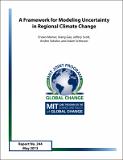| dc.contributor.author | Monier, Erwan | |
| dc.contributor.author | Gao, Xiang | |
| dc.contributor.author | Scott, Jeffery | |
| dc.contributor.author | Sokolov, Andrei | |
| dc.contributor.author | Schlosser, C. Adam | |
| dc.date.accessioned | 2013-06-10T17:10:22Z | |
| dc.date.available | 2013-06-10T17:10:22Z | |
| dc.date.issued | 2013-05 | |
| dc.identifier.uri | http://hdl.handle.net/1721.1/79080 | |
| dc.description.abstract | In this study, we present a new modeling framework and a large ensemble of climate projections to investigate the uncertainty in regional climate change over the US associated with four dimensions of uncertainty. The sources of uncertainty considered in this framework are the emissions projections (using different climate policies), climate system parameters (represented by different values of climate sensitivity and net aerosol forcing), natural variability (by perturbing initial conditions) and structural uncertainty (using different climate models). The modeling framework revolves around the Massachusetts Institute of Technology (MIT) Integrated Global System Model (IGSM), an integrated assessment model with an intermediate complexity earth system model (with a two-dimensional zonal-mean atmosphere). Regional climate change over the US is obtained through a two-pronged approach. First, we use the IGSM-CAM framework which links the IGSM to the National Center for Atmospheric Research (NCAR) Community Atmosphere Model (CAM). Secondly, we use a pattern-scaling method that extends the IGSM zonal mean based on climate change patterns from various climate models. Results show that uncertainty in temperature changes are mainly driven by policy choices and the range of climate sensitivity considered. Meanwhile, the four sources of uncertainty contribute more equally to precipitation changes, with natural variability having a large impact in the first part of the 21st century. Overall, the choice of policy is the largest driver of uncertainty in future projections of climate change over the US. | en_US |
| dc.description.sponsorship | This work was partially funded by the US Environmental Protection Agency under Cooperative
Agreement #XA-83600001. The Joint Program on the Science and Policy of Global Change is
funded by a number of federal agencies and a consortium of 40 industrial and foundation
sponsors. For a complete list of sponsors, see: http://globalchange.mit.edu. This research used the
Evergreen computing cluster at the Pacific Northwest National Laboratory. Evergreen is
supported by the Office of Science of the US Department of Energy under Contract No.
DE-AC05-76RL01830. The 20th Century Reanalysis V2 data was provided by the
NOAA/OAR/ESRL PSD, Boulder, Colorado, USA, from their Web site at
http://www.esrl.noaa.gov/psd/. | en_US |
| dc.language.iso | en_US | en_US |
| dc.publisher | MIT Joint Program | en_US |
| dc.relation.ispartofseries | MIT Joint Program Report Series;Report 244 | |
| dc.title | A Framework for Modeling Uncertainty in Regional Climate Change | en_US |
| dc.type | Technical Report | en_US |
| dc.identifier.citation | Report 244 | en_US |
